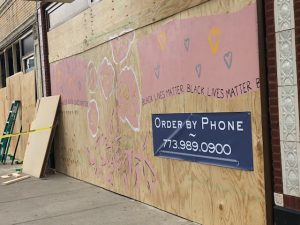 Early into living under shelter in place restrictions, I cut down on the frequency of my shopping trips.
Early into living under shelter in place restrictions, I cut down on the frequency of my shopping trips.
Since I tried to reduce the number of excursions I made, I started going to large stores, more likely to have everything I wanted, rather than go to small stores that were especially good at different things, my usual habit.
Knowing that smaller stores were starting to open for business, and wanting to support them, I traveled to the nearby Lincoln Square area to go to my favorite butcher.
I parked a couple blocks away and took a slow walk down Lincoln Avenue. I felt a little like a refugee returning to his village after a wartime bombing. Although I’ve walked past the Chase branch, the nail salon, the fancy sandwich shop, and the indie bookstore countless times, I felt like a stranger.
Just outside of the European-style natural health store, workmen, wearing utility belts and yellow hard hats, sawed flat plywood panels to size. I couldn’t tell if they were boarding up the store’s street facing side as a precaution or because display windows were broken by protestors during the past week.
It seemed that most demonstrations following the death of George Floyd took place downtown or at places of political or cultural significance. But protests took place in lower traffic areas, too. As befitting a universal wake-up call, I suppose, not everything proceeded quietly.
On one local business’s new plywood façade, I saw a simple chalk rendering of flowers, accompanied by stenciled words repeating, BLACK LIVES MATTER. Below these words, stamped in large print was a reminder that they were, indeed, open for business and that customers could “order by phone.”
A triumph in understanding? Obviously, the store owners recognized something very important.
Glass can be swept up. Even small businesses, which have suffered, can be brought back by new customers or loyal patrons. Lives cannot be replaced.
Although my marching days are behind me, I feel encouraged knowing that a diverse mixture of people are marching now. People have gathered peaceably together every day and night for over a week. They’ve been clamoring for racial and social justice.
I’ve heard the words “perfect storm” used a lot lately to call our collective attention to inequities that seemed to have been baked in to our society. The pandemic seems to have brought a lot of long-festering, but inadequately addressed, issues to the surface.
COVID case and morbidity statistics have shown that chances of catching the virus and dying from it have been disproportionately high among black and brown populations. Many factors contribute to this such as chronic health conditions like diabetes and hypertension, the lack of affordable healthcare, and the likelihood of holding a public-facing (service) job.
It may have been unexpected that the murder of George Floyd at the hands of a Minneapolis policeman got caught on video, but the mistreatment of African Americans and Latinos by police is far from unusual.
Maybe because the corona virus has meant lack of other news, the stories of Breonna Taylor and Ahmaud Arbery have gotten more than typical media attention. The short time gaps between these events during the era of COVID have aided in making this a perfect storm for outrage.
We might also be looking at a Perfect Storm for real change.
I see this era of COVID restrictions as creating an unusual opportunity for a cultural reset. If so many people were not out of work, if baseball was not on hiatus, if our local cineplex was not closed to new releases, if we were occupied with the usual distractions — if we hadn’t become attuned to death visiting so many Americans indiscriminately, unfairly — would we be taking time to examine inequities in our society?
If we weren’t living in such unusual times, amid the ravages of a pandemic, would so many people have the time or will to support sustained protests for change?
Tuning in to opportunities of the moment and examining what each of us can do to create a society in which we’d want to live, is no small thing.


Leave a comment